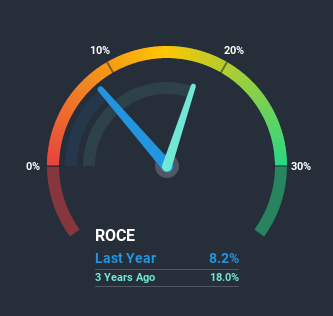Should You Be Impressed By Wyndham Hotels & Resorts' (NYSE:WH) Returns on Capital?

There are a few key trends to look for if we want to identify the next multi-bagger. Amongst other things, we'll want to see two things; firstly, a growing return on capital employed (ROCE) and secondly, an expansion in the company's amount of capital employed. This shows us that it's a compounding machine, able to continually reinvest its earnings back into the business and generate higher returns. However, after briefly looking over the numbers, we don't think Wyndham Hotels & Resorts (NYSE:WH) has the makings of a multi-bagger going forward, but let's have a look at why that may be.
Return On Capital Employed (ROCE): What is it?
For those who don't know, ROCE is a measure of a company's yearly pre-tax profit (its return), relative to the capital employed in the business. To calculate this metric for Wyndham Hotels & Resorts, this is the formula:
Return on Capital Employed = Earnings Before Interest and Tax (EBIT) ÷ (Total Assets - Current Liabilities)
0.082 = US$369m ÷ (US$4.8b - US$343m) (Based on the trailing twelve months to June 2020).
Therefore, Wyndham Hotels & Resorts has an ROCE of 8.2%. In absolute terms, that's a low return, but it's much better than the Hospitality industry average of 6.1%.
See our latest analysis for Wyndham Hotels & Resorts
Above you can see how the current ROCE for Wyndham Hotels & Resorts compares to its prior returns on capital, but there's only so much you can tell from the past. If you'd like to see what analysts are forecasting going forward, you should check out our free report for Wyndham Hotels & Resorts.
So How Is Wyndham Hotels & Resorts' ROCE Trending?
On the surface, the trend of ROCE at Wyndham Hotels & Resorts doesn't inspire confidence. Around four years ago the returns on capital were 18%, but since then they've fallen to 8.2%. Given the business is employing more capital while revenue has slipped, this is a bit concerning. If this were to continue, you might be looking at a company that is trying to reinvest for growth but is actually losing market share since sales haven't increased.
On a related note, Wyndham Hotels & Resorts has decreased its current liabilities to 7.1% of total assets. That could partly explain why the ROCE has dropped. What's more, this can reduce some aspects of risk to the business because now the company's suppliers or short-term creditors are funding less of its operations. Some would claim this reduces the business' efficiency at generating ROCE since it is now funding more of the operations with its own money.
Our Take On Wyndham Hotels & Resorts' ROCE
In summary, we're somewhat concerned by Wyndham Hotels & Resorts' diminishing returns on increasing amounts of capital. And, the stock has remained flat over the last year, so investors don't seem too impressed either. With underlying trends that aren't great in these areas, we'd consider looking elsewhere.
One more thing: We've identified 2 warning signs with Wyndham Hotels & Resorts (at least 1 which is significant) , and understanding these would certainly be useful.
While Wyndham Hotels & Resorts isn't earning the highest return, check out this free list of companies that are earning high returns on equity with solid balance sheets.
This article by Simply Wall St is general in nature. It does not constitute a recommendation to buy or sell any stock, and does not take account of your objectives, or your financial situation. We aim to bring you long-term focused analysis driven by fundamental data. Note that our analysis may not factor in the latest price-sensitive company announcements or qualitative material. Simply Wall St has no position in any stocks mentioned.
Have feedback on this article? Concerned about the content? Get in touch with us directly. Alternatively, email editorial-team@simplywallst.com.

